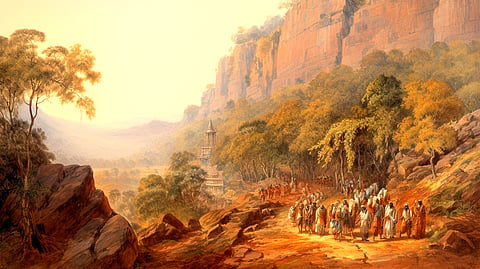- Commentary
- History Vignettes
- Notes on Culture
- Dispatches
- Podcasts
- Indian LanguagesIndian Languages
- Support

AFTER RESTING IN TIRUPATI, V.N. Narasimhan sets out for Tirumala the next day. He gives a blow-by-blow account of the journey. His high position in the officialdom of Mysore enables him to make a part of the sacred journey in a palanquin.
Read on!
16th Decemher 1872 — Tirupati
THE FIRST RANGE OF HILLS presents to the distant observer the form of a huge serpent, lying on the ground with its body extended in curves. This is due to the depressions in the surface of the range. Hence the whole is dubbed Seshachala or mountain of Sesha. The sthala purana goes to say that the hills are the avatars of the serpentine god.
The dhooley bearers keep singing one after another in a monotonous tone. The refrains are noom and volee. The ascent is very steep for the first two miles, the primitive road maker not having very extended ideas of road making. The whole way up is covered with stone steps, the smoothness of which bespeak the countless millions of devotees who have gone over them. The way up to the gali gopuram is exceptionally steep and difficult.
We hurriedly estimated the gradient to be in some places one in three. Almost all the steps are engraved with the names and particular acts of pilgrims. The engravings have been much worn off by the feet of subsequent visitors to the temple. The hill sides are covered with scrub jungle which, I was told, shelter all sorts of wild animals, excepting perhaps the elephant and lion.
The first gopuram or gate is the aforesaid gali gopuram. There is a Bhairagi Matha here which is richly endowed with inams for feeding the pilgrims. We did not observe that there was any show of hospitality. The trees in these jungles, although proudly looked upon by the natives of the country, are pigmies when compared with the giants of the Western Ghats.
In one part of the road, up to the top of the hills, there is a precipice with perpendicular sides, which reminded me of the Western Ghats. It was very grand, looking into it from the brink and as the road was not parapeted in some places, I could not help feeling exceedingly nervous and uncomfortable when the bearers hurried my dhooley close to the mouth of the yawning abyss.
One of the curses of the shrine is the number of unfortunate and threatening beggars who beset all the pilgrims and chance visitors…
After a weary trudge of nearly ten miles over seven hills, the dhooley was at last deposited in front of a ruined gate. It appears no one is allowed, out of respect to the God, to proceed in dhooley or palanquin beyond the gate. The Svami of Sringcri was an exception so far as to be able to go a few yards further. It is a rule of the shrine that no one can ascend the hill with shoes on. We were all bare-footed.
The small polyangular pebbles which pave the way up the hill made alarming gashes and cracks in our soles. After leaving the dhooleys, we proceeded on foot to the next gate which is still more dilapidated. To the left is a stone mantap with a thousand carved pillars, which was under repair when we visited the shrine. Turning to the left, we came upon a street, which led us to the gate of the temple and which gradually descended to the level of another street running at right angles to it. There was a stream of water, the draining of the small settlement, running along this street.
There is a bathing pond, Svami Pushkarini, whose water was full of organic impurities and covered with a pretty thick green scum. The local Purana says that there are nine teerthams or holy waters in it.
The architecture of the temple is of the same style and age as that of the temple in the town of Tirupati. Some of the pillars were more richly carved and there is another Kalyana Mantapam of the same kind as the one below, only this is in a better state of preservation. There are several stone and bronze statues of bygone kings whose donations to the temple tend to swell its revenue…
In the inner compound, there is a well whose origin is mythological and it is said that flowers which would float in any other water would sink at once in this. We tried the experiment and it was not proved.
On gliding past the vestibule, leaving the outer gate, where a bell is incessantly being tolled, we could see the great God Srinivasa here visible in all his glory. It is an idol about seven feet high standing on a high pedestal, with four arms and cut of a fine-grained blackstone. It was coated with gold armour and bejewelled ornaments. The forehead was adorned by two large perpendicular streaks of pachcha karpuram in imitation of the tri-marks. The first two arms hold golden representations of the Sankha and Chakra which were not originally cut out of the stone block. They were, however, blackened so far as to appear to be stone to the uninitiated.
This is the god which attracts so many devotees from all parts of India.
To be continued
The Dharma Dispatch is now available on Telegram! For original and insightful narratives on Indian Culture and History, subscribe to us on Telegram.
